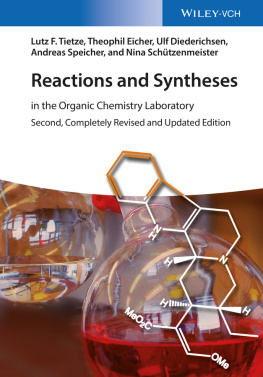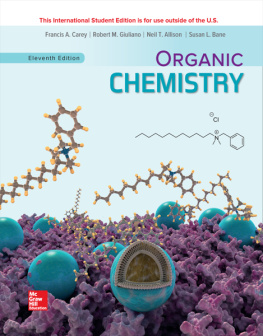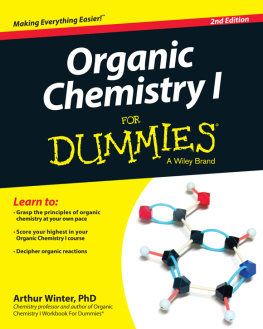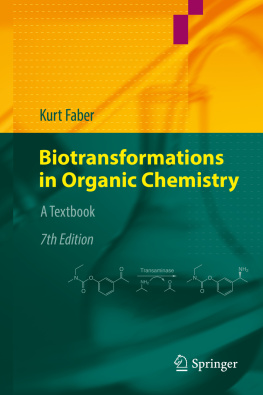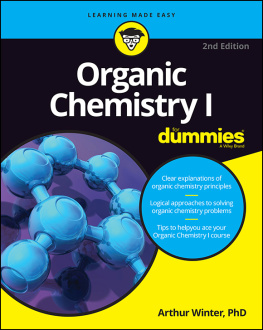
Related Titles
Gaich, T., Winterfeldt, E.
Directed Selectivity in Organic Synthesis
A Practical Guide
2014
Print ISBN: 978-3-527-33375-2, also available in digital formats
Singh, M.
Reactive Intermediates in Organic Chemistry
Structure, Mechanism, and Reactions
2014
Print ISBN: 978-3-527-33594-7, also available in digital formats
Zaragoza Drwald, F.
Side Reactions in Organic Synthesis II
Aromatic Substitutions
2014
Print ISBN: 978-3-527-33721-7, also available in digital formats
Schlosser, M. (ed.)
Organometallics in Synthesis, Third Manual
2013
Print ISBN: 978-0-470-12217-4, also available in digital formats
Smith, M.B.
March's Advanced Organic Chemistry
Reactions, Mechanisms, and Structure
Seventh Edition 2013
Print ISBN: 978-0-470-46259-1, also available in digital formats
Zubrick, J.W.
The Organic Chem Lab Survival Manual
A Student's Guide to Techniques
Ninth Edition 2013
Print ISBN: 978-1-118-08339-0, also available in digital formats
Lipshutz, B.H. (ed.)
Organometallics in Synthesis, Fourth Manual
2013
Print ISBN: 978-1-118-48882-9, also available in digital formats
Hanessian, S., Giroux, S., Merner, B.L.
Design and Strategy in Organic Synthesis
From the Chiron Approach to Catalysis
2013
Print ISBN: 978-3-527-31964-0
Sierra, M.A., de la Torre, M.C., Cossio, F.P.
More Dead Ends and Detours
En Route to Successful Total Synthesis
2013
Print ISBN: 978-3-527-32976-2, also available in digital formats
The Authors
Prof. Dr. Lutz F. Tietze
Georg-August-University Gttingen
Institute of Organic and Biomolecular Chemistry
Tammannstr. 2
37077 Gttingen
Germany
Prof. Dr. Theophil Eicher
Saarland University
Campus B6.1
66123 Saarbrcken
Germany
Prof. Dr. Ulf Diederichsen
Georg-August-University Gttingen
Institute of Organic and Biomolecular Chemistry
Tammannstr. 4
37077 Gttingen
Germany
Prof. Dr. Andreas Speicher
Saarland University
FR 8.1 - Organic Chemistry
Campus C4.2
66041 Saarbrcken
Germany
Dr. Nina Schtzenmeister
University of Bristol
School of Chemistry
Cantock's Close
Bristol, BS8 1TS
UK
Cover
The cover image was kindly supplied by Professor Lutz F. Tietze.
All books published by Wiley-VCH are carefully produced. Nevertheless, authors, editors, and publisher do not warrant the information contained in these books, including this book, to be free of errors. Readers are advised to keep in mind that statements, data, illustrations, procedural details or other items may inadvertently be inaccurate.
Library of Congress Card No.: applied for
British Library Cataloguing-in-Publication Data
A catalogue record for this book is available from the British Library.
Bibliographic information published by the Deutsche Nationalbibliothek
The Deutsche Nationalbibliothek lists this publication in the Deutsche Nationalbibliografie; detailed bibliographic data are available on the Internet at .
2014 Wiley-VCH Verlag GmbH & Co. KGaA, Boschstr. 12, 69469 Weinheim, Germany
All rights reserved (including those of translation into other languages). No part of this book may be reproduced in any form by photoprinting, microfilm, or any other means nor transmitted or translated into a machine language without written permission from the publishers. Registered names, trademarks, etc. used in this book, even when not specifically marked as such, are not to be considered unprotected by law.
Print ISBN: 978-3-527-33814-6
ePDF ISBN: 978-3-527-68872-2
ePub ISBN: 978-3-527-68874-6
Mobi ISBN: 978-3-527-68873-9
Preface to the First Edition
1 Background
The book Reaktionen und Synthesen im organisch-chemischen Praktikum und Forschungslaboratorium was first published in German in 1981, with a second edition in 1991, and was translated into Japanese in 1984 (second edition 1995), English in 1989, Chinese in 1999, Russian in 2000, and Korean in 2002. The intention was
- to associate classes of compounds and functionalities with reaction types and mechanisms,
- to offer a great number of reliable preparative procedures of general importance, and
- to show the usefulness and robustness of the offered procedures for the synthesis of selected interesting compounds of relevance in biology, pharmacy, and medicine.
Since the last German edition, many new preparative procedures have been developed showing high chemo, regio, diastereo, and enantioselectivity, which frequently approach the selectivity of enzymatic transformations with the advantage of lower substrate specificity. In addition, new methods such as combinatorial chemistry, solid-phase chemistry, high-pressure chemistry, and the use of microwaves for heating have been introduced. Moreover, the efficiency of a synthesis, which can be defined as the increase in complexity per transformation, the avoidance of toxic reagents and solvents, and the preservation of resources are important issues in modern preparative organic chemistry. Significant developments in the last years have been realized in transition-metal catalysis, organocatalysis, and domino reactions. This progress has been impressively documented in Classics of Total Synthesis [1], Organic Synthesis Highlights [2], and Domino Reactions in Organic Synthesis [3].
As a consequence, we now present this book Reactions and Syntheses in the Organic Chemistry Laboratory in a new form with respect to its concept and organization and extensively renewed with respect to its content.
Its major highlights are as follows:
- The basic units as well as the main objectives are syntheses (up to multistep syntheses with more than five steps) of interesting and instructive target molecules from various fields of organic chemistry. Each synthesis is centered around one or more methods and reaction principles of general synthetic relevance.
- As before, the users of the new book are provided with carefully elaborated experiments, which are described in preparative and analytical detail. However, experiments and syntheses are accompanied throughout in concentrated form by the required general, theoretical, and mechanistic background and explanations. Special attention is given to retrosynthetic analysis and alternative approaches of synthesis for a given target molecule.
- To allow the inclusion of a representative and qualified spectrum of contemporary synthetic methods, more than 70% of the content of the former book has been replaced by more recent and more relevant experimental examples. The remaining (older) syntheses have been updated with respect to description of their general background.
Considering the various types of users of the book in the past, there has been a definite and broad acceptance among chemists and pharmacists on a more advanced level, besides graduate students and researchers in universities and industry. From these considerations, the following consequences have emerged for the third edition:
- General laboratory information, such as safety, first aid, performance of chemical reactions, instrumentation and standard apparatus, and isolation and purification of products, has been omitted. Methods for the formation and transformation of basic functional groups in organic compounds, regarded as important at the elementary education level in organic laboratory practice, are not described. These topics are comprehensively covered in other relevant textbooks [46].
Next page
